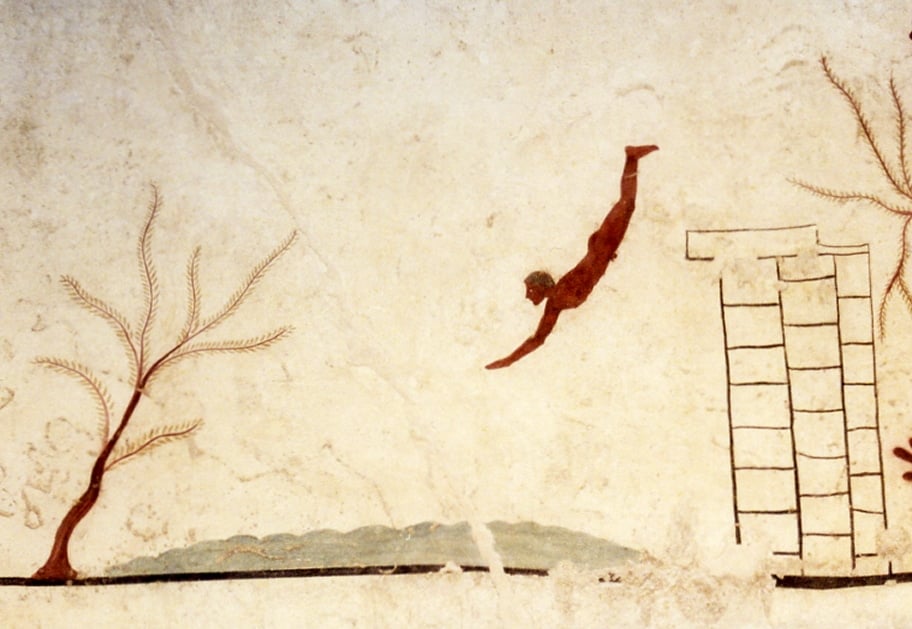Cold Water Therapy and Winter Swimming in Ancient Greece
Source: GreekReporter.com

Cold water therapy was popular among ancient Greeks, and this is one of the reasons they established elaborate bathhouses for wellness and relaxation.
Greek physicians like Hippocrates, the father of modern medicine, extolled the virtues of cold bathing. They believed that immersion in cold water could invigorate the body and stimulate circulation, aligning with their holistic approach to medicine. Hippocrates also discovered that putting ice on an open wound stops bleeding.
In Hippocrates’ work entitled “On airs, waters and places,” he makes the statement that “water can cure everything,” further emphasizing its therapeutic value. The great ancient Greek philosopher Plato also praised the benefits of immersing the body in very cold water.
Later, in the 2nd century AD, Greek physician Galen of Pergamon used cold water therapy. He immersed a patient with tertian fever into iced water.
Winter swimming also generally has therapeutic effects on muscles. The ancients used to dive in cold water for rejuvenation. Hippocrates wrote that he enjoyed diving into the “magical waters,” as he referred to the cold sea, every time he wanted to alleviate particular aches and pains.
Ancient Greeks believed in the healing power of hydrotherapy and incorporated the use of cold water in their daily lives for better health.
Wintertime swimming was also popular, as it combined the therapeutic powers of immersing oneself in cold water along with fine exercise for the whole body.
Cold water therapy routines often involved immersing the body in a cold plunge pool or ice bath tubs. This process was believed to have health benefits, both physical and mental.
Greek and Roman public baths
While Athenians were taking cold and warm baths depending on the occasion, the hardened Spartans only bathed in the cold waters of River Evrotas to tighten their muscles. Similarly, Macedonians only took cold baths because they believed that hot water makes men sloth.
The ancient Greeks’ idea of a bath was a plunge into particularly cold water. From the 5th century on, public baths were introduced. One of their purposes was hydrotherapy, and public baths had to provide cold and hot water as well.
Hydrotherapy required features that were essential in Greek public baths. Some of the prominent elements included tholoi, hip baths, and other types of baths and pools, as well as water and heating systems.
In addition to cold water therapy, the Greeks also utilized thermal springs, recognizing that warm water offers distinct soothing benefits compared to cold. Both cold and hot water therapies were originally employed to treat conditions such as skin diseases, muscle pain, and joint discomfort.
This was known as thermalism. It involved water at varying temperatures ranging from cold to hot. Thermalism was one of the many innovations of ancient Greeks in hydrotherapy. Aside from reducing muscle fatigue, it was used to ease other health conditions as well. The public baths were called thermae.
The public baths served both as places for personal hygiene and social interaction. They often featured various pools of water at different temperatures, enabling patrons to immerse themselves in cold water after enjoying the hot springs.
The benefits of cold water immersion in ancient Greece transcended the physical realm. It held spiritual significance, seen as a means of cleansing the body and mind, bringing clarity to the soul. Immersion in cold water was often regarded as a purifying ritual, a practice that helped individuals draw closer to the gods and divine forces.
The Roman baths were a continuation of the Greek thermae. They were also elaborate buildings but grander and more sophisticated. For cold water therapy, they had pools of iced water called frigidaria.
Soon, the Roman baths became centers for relaxation and socialization and larger in size as well as more impressive.
Cold water therapy today
Today, cold water therapy is popular across the world for its wide range of mental and physical benefits. People from almost all walks of life can benefit from cold plunges, whether it is through winter swimming or immersing themselves in iced water in a spa.
It is an alternative method to improving health and well-being and is used by some for muscle recovery and injury prevention, as well as by people looking to boost their immune system and increase resistance. Cold water soothes muscle soreness and reduces stress and fatigue.
More recently, winter swimming has captured the interest of many. Research shows that an icy dip has multiple benefits, both for the body and the spirit. Cold water strengthens the immune system, activates the metabolism, and is similar to abdominal exercise.
When immersing oneself in very cold water, the body releases endorphins, the so-called “hormones of happiness,” which not only support mental well-being but also have analgesic properties lasting from 2 to 4 hours.
Swimming in the winter strengthens the muscles, and people who suffer from rheumatic diseases, fibromyalgia, and other musculoskeletal diseases report that winter swimming has a palliative effect on them.
Swimming in the sea in winter increases endurance and stimulates the muscular, cardiovascular, and respiratory systems, and it also improves metabolism. Cold water activates the skin thermo-receptors, which command the brain to increase the heartbeat, so one feels rejuvenated.
According to research, cold water boosts dopamine levels by up to 530 percent. In a study published in The British Medical Journal, it was reported that winter swimming helps to deal with depression by acting as a substitute for antidepressants. Furthermore, it decreases stress levels and boosts self-confidence.
The original article: belongs to GreekReporter.com .
